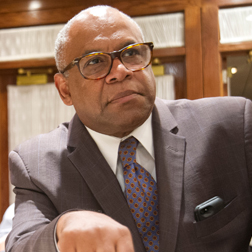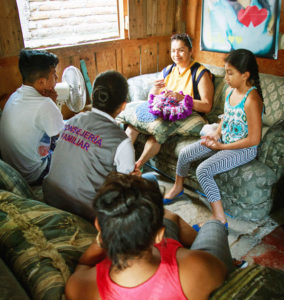[vc_row][vc_coluna][vc_column_text]
Abordagem de prevenção da violência secundária migra de Los Angeles para Honduras, O salvador & Tunísia
Por Jillian Slutzker
[/vc_column_text][/vc_coluna][/vc_row][vc_row][largura da coluna_vc=”2/3″][vc_column_text]LOS ANGELES – In communities across El Salvador, Honduras e Tunísia, os jovens com maior risco de cometer violência participam em programas concebidos para reduzir o risco de darem o próximo passo.
This targeted intervention—known as “secondary violence prevention”—aims to reach individuals who are most vulnerable to joining gangs or violent groups and taking part in violence themselves.
“In any high risk community it’s a very small percentage of the youth that we need to dedicate concentrated attention to,” said Guillermo Cespedes, speaking at the Sixth Annual Conferência de Prevenção e Intervenção de Gangues de Los Angeles em maio 1.
Cespedes serves as Deputy Chief of Party for Proponte Más secondary violence prevention program em Honduras. Financiado pelos EUA. Agência para o Desenvolvimento Internacional e implementada pela Creative Associates International, the program works with 800 families with members ages 8 para 17 correm o maior risco de participar em violência.
Ao longo de um ano, trained family counselors work in close partnership with youth and their families to address problem-solving, change negative family dynamics and lower the risk factors for gang joining.
Enquanto isso, youth at a “primary” level live in at-risk areas and their issues are addressed through sports leagues, life skills classes and jobs programs.
To learn more about the Proponte Más program, please visit “Inside a family-based approach to reach youth most at risk for committing violence.”
Adapting a tool developed in Los Angeles

To identify which youth fall into a secondary level of risk, Cespedes and his colleagues on Creative Associates’ Segurança Cidadã team are adapting a risk assessment method known as the Youth Service Eligibility Tool, which was developed in Los Angeles.
The Youth Service Eligibility Tool assesses youth risk across a series of nine risk factors at an individual, nível de pares e familiares. It provides a data-driven measurement to determine which youth are most at risk of joining a gang or violent group, who are placed into this “secondary” risk level.
The City of Los Angeles’ Gang Reduction and Youth Development Office, headed by Cespedes at the time, began to use a more holistic family-based approach after having limited success trying to treat youth for each risk factor separately and providing them with programming and services as individuals.
Creative Associates currently applies adapted versions of the Youth Service Eligibility Tool and family-based secondary violence prevention approach in El Salvador, Honduras and Tunisia and will soon begin a secondary prevention intervention in the Eastern and Southern Caribbean as part of the USAID-funded Comunidade, Programa de Resiliência Familiar e Juvenil.
Family-based approach and results in Honduras
Cespedes says that by working with the families of youth most at risk for violence, Proponte Más counselors can help establish positive problem-solving mechanisms and reinforce existing family assets, rather than avoid the family and highlight family deficits or pathologies as past programs have tended to do.
“We’re constantly fueling this idea that what the world says your family is, is not really what your family is. Your family has a lot of assets,"ele disse.

Whether families are headed by aunts, brothers or grandparents and whether members are living abroad or under the same roof, the program aims to strengthen family leadership in whatever form it exists.
By working to improve family problem-solving mechanisms, even on items as seemingly simple as household chores and homework, counselors help to improve what Cespedes calls “the relational dance of the family,” in which negative behaviors associated with the risk factors become embedded.
In a low resource context like Honduras, as opposed to a city like Los Angeles which may offer more support, “wrapping the family around an at-risk youth,” as Cespedes says, is a smart approach.
“The resources we look for, because there aren’t a lot of programmatic resources in Honduras, are family resources, emotional and spiritual resources,"ele disse.
The program is showing positive results. Fora de 437 youth in the initial treatment who tested at a secondary prevention level, 73.7 percent were no longer at a secondary prevention level after six months of treatment.
These changes can also be seen in in a reduction in individual risk factors. Por exemplo, comportamentos como carregar armas escondidas, tráfico de drogas ou brigas de grupo com gangues, entre outros, estão ligados a um fator de risco conhecido como “Delinquência Associada ao Abuso de Substâncias.”
After six months of family intervention, youth in the program showed significant declines in this risk factor: with an average reduction of 30.2 por cento em Tegucigalpa; 34.4 por cento em La Ceiba; 30.8 por cento em Tela; 33.3 por cento em San Pedro Sula; e 38.7 por cento em Choloma.
To add to these initial results, the program will be implementing a randomized control evaluation with Arizona State University in the coming months.
One leg of a four-legged table
Cespedes cautions that as secondary prevention is adapted and applied in different context, program implementers must keep in mind that secondary prevention is one leg of a four-legged table and cannot stand alone for long.
The four table legs—primary prevention, secondary prevention, prevenção terciária (supporting reintegration for youth who have already joined a gang or come in conflict with the law) and sensible law enforcement—work best when applied simultaneously in a single place as part of a coordinated place-based approach, disse Céspedes.
“One leg of prevention by itself is a little bit like a table with one leg. It’s not going to be very balanced… it has to be attached to the other three legs,” he said.[/vc_column_text][/vc_coluna][largura da coluna_vc=”1/12″][/vc_coluna][largura da coluna_vc=”1/4″][vc_widget_sidebar barra lateral_id=”barra lateral primária”][/vc_coluna][/vc_row]